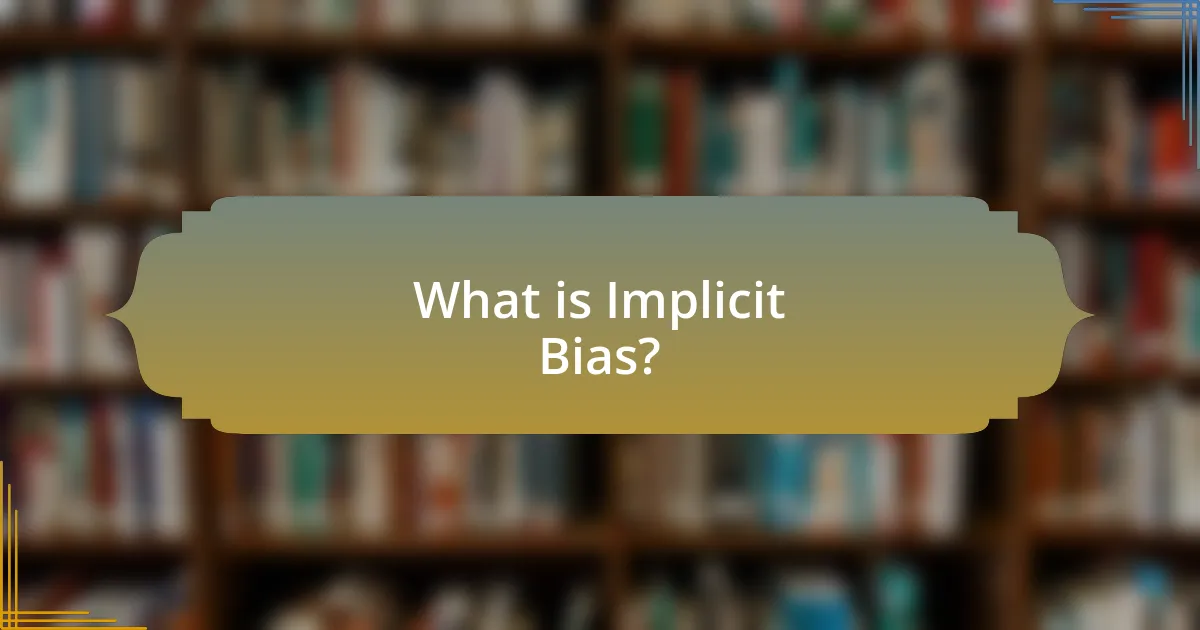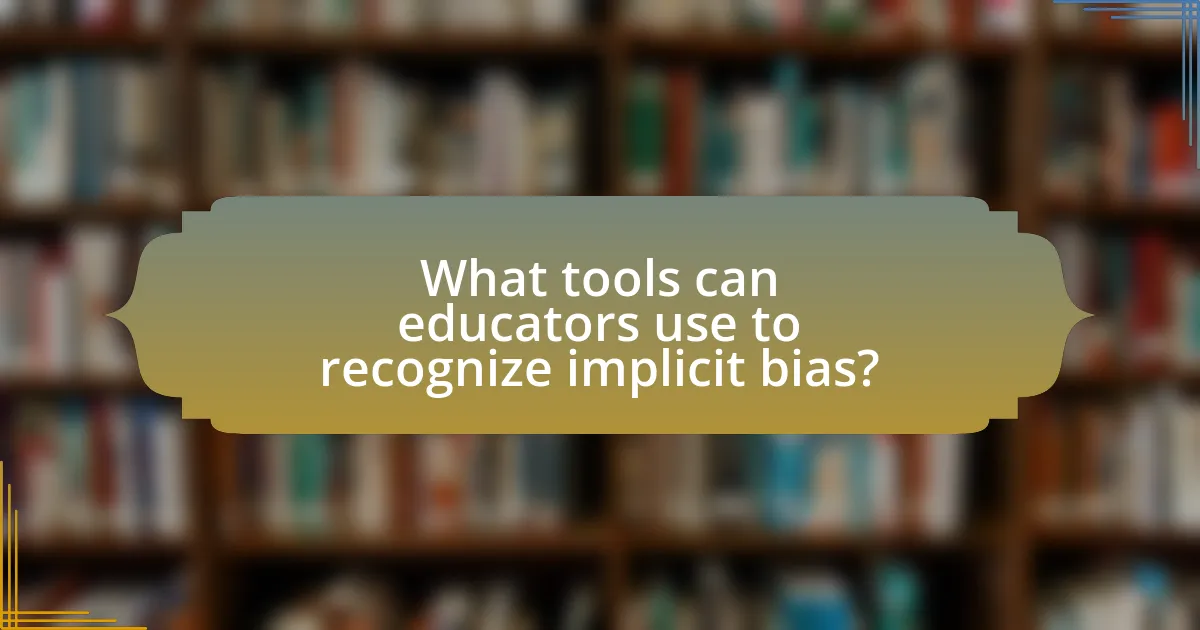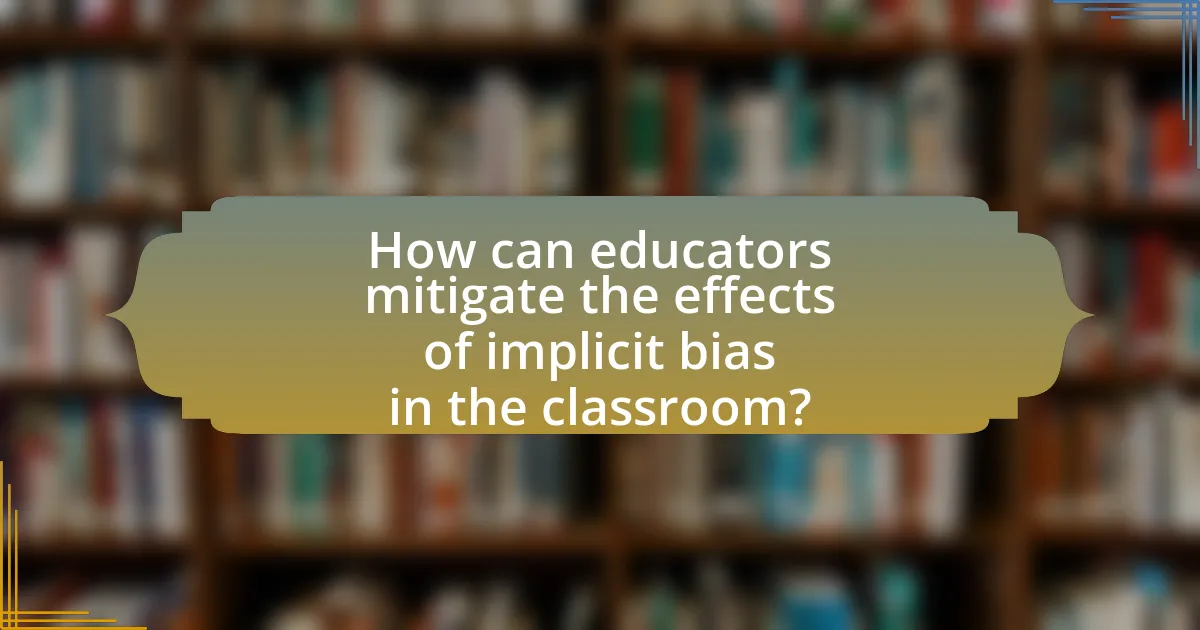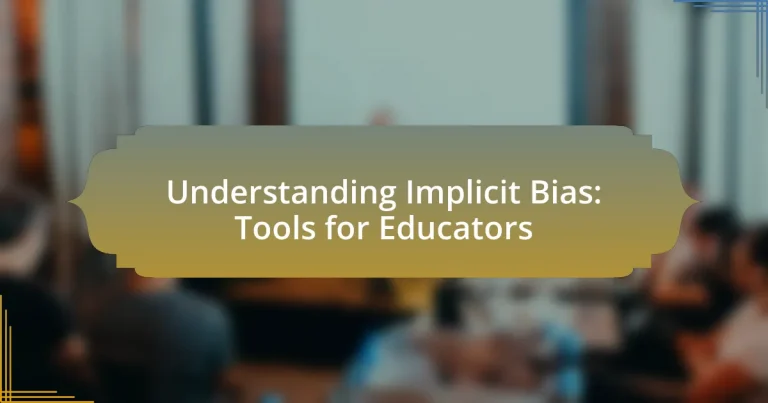Implicit bias refers to the unconscious attitudes and stereotypes that influence our understanding and actions towards individuals, particularly in educational settings. This article explores the definition of implicit bias, its psychological foundations, and its impact on student outcomes and classroom dynamics. It highlights the importance of recognizing implicit bias for educators, detailing effective tools and strategies for self-assessment, training, and curriculum design to mitigate bias. Additionally, the article discusses best practices for fostering an inclusive classroom culture and engaging with families and communities to combat bias, ultimately aiming to promote equity in education.

What is Implicit Bias?
Implicit bias refers to the unconscious attitudes or stereotypes that affect our understanding, actions, and decisions regarding people. Research indicates that these biases can influence behavior in various contexts, including education, where they may impact teacher expectations and student performance. A study by the American Psychological Association found that implicit biases can lead to disparities in disciplinary actions among students of different racial backgrounds, highlighting the significant effects of these unconscious biases in educational settings.
How is implicit bias defined in educational contexts?
Implicit bias in educational contexts is defined as the unconscious attitudes or stereotypes that affect understanding, actions, and decisions in the classroom. These biases can influence teacher expectations, student interactions, and disciplinary actions, often leading to disparities in educational outcomes. Research indicates that implicit bias can result in lower academic performance for marginalized groups, as teachers may unknowingly favor certain students over others based on race, gender, or socioeconomic status. For instance, a study published in the journal “Psychological Science” found that teachers’ implicit biases can significantly impact their perceptions of student behavior and academic potential, ultimately affecting students’ educational experiences and achievements.
What are the psychological foundations of implicit bias?
The psychological foundations of implicit bias stem from cognitive processes that categorize and stereotype individuals based on social group characteristics. These biases are often automatic and unconscious, arising from the brain’s tendency to simplify complex social information through heuristics. Research indicates that implicit biases are influenced by societal norms, personal experiences, and cultural contexts, which shape perceptions and attitudes toward different groups. For instance, a study by Greenwald and Banaji (1995) introduced the Implicit Association Test, demonstrating that individuals can hold biases that contradict their conscious beliefs, highlighting the pervasive nature of implicit bias in decision-making and behavior.
How does implicit bias differ from explicit bias?
Implicit bias refers to the unconscious attitudes or stereotypes that affect our understanding, actions, and decisions, while explicit bias involves conscious beliefs and attitudes that individuals are aware of and can articulate. Research indicates that implicit biases can influence behavior without the individual’s awareness, as demonstrated in studies like the Implicit Association Test, which reveals automatic associations between social groups and attributes. In contrast, explicit biases are often expressed openly and can be measured through self-report surveys, reflecting a person’s deliberate beliefs. This distinction is crucial for educators aiming to address bias in educational settings, as it highlights the need for strategies that target both unconscious and conscious biases.
Why is understanding implicit bias important for educators?
Understanding implicit bias is crucial for educators because it directly influences their interactions with students and affects educational outcomes. Educators who recognize their own implicit biases can create a more equitable learning environment, fostering inclusivity and reducing disparities in student performance. Research indicates that implicit biases can lead to differential treatment of students based on race, gender, or socioeconomic status, which can hinder the academic success of marginalized groups. For instance, a study published in the journal “Psychological Science” found that teachers’ implicit biases significantly impacted their expectations and evaluations of students, ultimately affecting students’ self-esteem and achievement. By understanding and addressing these biases, educators can implement strategies that promote fairness and support all students’ learning experiences.
What impact does implicit bias have on student outcomes?
Implicit bias negatively impacts student outcomes by influencing educators’ perceptions and interactions with students. Research indicates that teachers may unconsciously hold lower expectations for students from marginalized backgrounds, which can lead to reduced academic performance and engagement. For instance, a study published in the journal “Psychological Science” found that teachers’ implicit biases can affect their grading practices, resulting in minority students receiving lower grades despite similar performance levels compared to their peers. This bias can perpetuate achievement gaps and hinder the overall educational experience for affected students.
How can implicit bias affect classroom dynamics?
Implicit bias can significantly affect classroom dynamics by influencing teachers’ perceptions and interactions with students. When educators hold unconscious biases, they may unintentionally favor certain students over others, impacting engagement and participation. Research indicates that teachers’ expectations can shape student performance; for instance, a study by Rosenthal and Jacobson demonstrated that students labeled as “high potential” performed better due to increased teacher attention and support. Consequently, implicit bias can lead to disparities in academic opportunities, classroom behavior management, and overall student outcomes, reinforcing existing inequalities in educational settings.

What tools can educators use to recognize implicit bias?
Educators can use tools such as the Implicit Association Test (IAT), bias training workshops, and reflective practices to recognize implicit bias. The IAT, developed by researchers at Harvard University, measures the strength of associations between concepts and evaluations, providing insights into unconscious biases. Bias training workshops, often based on research from organizations like the Kirwan Institute for the Study of Race and Ethnicity, educate educators about the nature of implicit bias and its impact on decision-making. Reflective practices, including journaling and peer discussions, encourage educators to examine their own beliefs and behaviors critically, fostering awareness of potential biases in their teaching.
How can self-assessment tools help educators identify their biases?
Self-assessment tools can help educators identify their biases by providing structured frameworks for reflection and evaluation of their beliefs and behaviors. These tools often include questionnaires and surveys that prompt educators to consider their attitudes towards different student demographics, thereby revealing unconscious biases. Research indicates that self-reflection facilitated by these tools can lead to increased awareness and understanding of personal biases, which is essential for fostering an inclusive educational environment. For instance, a study published in the Journal of Educational Psychology found that educators who engaged in self-assessment reported a greater recognition of their biases and a commitment to addressing them in their teaching practices.
What are some effective self-assessment tools available?
Effective self-assessment tools for understanding implicit bias include the Implicit Association Test (IAT), the Harvard Project Implicit website, and the Bias Awareness Toolkit. The IAT measures the strength of associations between concepts and evaluations, providing insights into unconscious biases. The Harvard Project Implicit website offers a range of tests that allow individuals to explore their implicit biases across various domains, including race, gender, and age. The Bias Awareness Toolkit provides educators with resources and reflection prompts to assess their own biases and develop strategies for addressing them in their teaching practices. These tools are validated by research in psychology and education, demonstrating their effectiveness in promoting self-awareness and bias recognition.
How can reflection exercises enhance awareness of implicit bias?
Reflection exercises enhance awareness of implicit bias by prompting individuals to critically examine their thoughts, feelings, and behaviors related to biases. These exercises encourage self-assessment and introspection, allowing individuals to identify and confront their unconscious biases. Research indicates that engaging in structured reflection can lead to increased recognition of implicit biases, as individuals become more aware of their automatic responses and the societal influences that shape them. For example, a study published in the Journal of Personality and Social Psychology found that reflective practices can significantly reduce implicit bias by fostering a deeper understanding of personal beliefs and attitudes.
What role does training play in addressing implicit bias?
Training plays a crucial role in addressing implicit bias by increasing awareness and providing strategies to mitigate its effects. Through structured programs, individuals learn to recognize their own biases and understand how these biases can influence decision-making and interactions with others. Research indicates that training can lead to significant reductions in biased behaviors; for example, a study published in the Journal of Personality and Social Psychology found that participants who underwent implicit bias training showed a 30% decrease in biased responses compared to those who did not receive training. This evidence underscores the effectiveness of training as a tool for educators to foster a more equitable environment.
What types of training programs are most effective for educators?
The most effective training programs for educators focus on understanding implicit bias, culturally responsive teaching, and active learning strategies. Programs that incorporate interactive workshops, case studies, and role-playing exercises have been shown to enhance educators’ awareness and skills in addressing bias in the classroom. Research indicates that training that includes ongoing support and follow-up sessions leads to more sustained changes in teaching practices. For instance, a study by the National Education Association found that educators who participated in comprehensive implicit bias training demonstrated a 30% increase in their ability to recognize and mitigate bias in their teaching methods.
How can ongoing professional development support bias reduction?
Ongoing professional development can support bias reduction by providing educators with training that enhances their awareness of implicit biases and equips them with strategies to mitigate these biases in their teaching practices. Research indicates that structured training programs, such as those focusing on cultural competency and anti-bias education, can lead to significant changes in educators’ attitudes and behaviors towards diverse student populations. For instance, a study published in the Journal of Educational Psychology found that educators who participated in bias training demonstrated improved interactions with students from various backgrounds, resulting in a more inclusive classroom environment. This evidence underscores the effectiveness of continuous professional development in fostering an understanding of bias and promoting equitable educational practices.

How can educators mitigate the effects of implicit bias in the classroom?
Educators can mitigate the effects of implicit bias in the classroom by implementing structured training programs that focus on recognizing and addressing their own biases. Research indicates that professional development programs, such as those outlined in the study “Implicit Bias in the Classroom” by the American Psychological Association, can significantly reduce biased behaviors and improve equitable teaching practices. Additionally, educators can utilize strategies like reflective practices, diverse curriculum materials, and inclusive classroom discussions to create an environment that acknowledges and values diversity, thereby counteracting the influence of implicit biases on student interactions and assessments.
What strategies can educators implement to reduce bias in their teaching?
Educators can implement strategies such as incorporating diverse perspectives in the curriculum, utilizing inclusive teaching practices, and engaging in ongoing bias training to reduce bias in their teaching. By integrating materials that reflect a variety of cultures and viewpoints, educators can create a more equitable learning environment. Research indicates that inclusive teaching practices, such as cooperative learning and differentiated instruction, help to mitigate bias by promoting collaboration among students from different backgrounds. Additionally, ongoing bias training for educators has been shown to increase awareness of implicit biases, leading to more mindful interactions with students and improved educational outcomes.
How can inclusive teaching practices promote equity?
Inclusive teaching practices promote equity by ensuring that all students, regardless of their backgrounds or abilities, have equal access to learning opportunities. These practices involve adapting teaching methods, materials, and assessments to meet diverse needs, thereby reducing barriers to participation. Research indicates that inclusive classrooms lead to improved academic outcomes for marginalized groups, as they foster a sense of belonging and engagement. For instance, a study published in the “Journal of Educational Psychology” found that inclusive practices significantly enhance the academic performance of students with disabilities, demonstrating that equitable access to education benefits all learners.
What role does curriculum design play in addressing implicit bias?
Curriculum design plays a crucial role in addressing implicit bias by intentionally integrating diverse perspectives and inclusive content into educational materials. This approach helps to challenge stereotypes and promote critical thinking among students, fostering an environment where all voices are valued. Research indicates that curricula that reflect a variety of cultural backgrounds can reduce bias and improve empathy, as evidenced by studies showing that students exposed to diverse narratives demonstrate greater understanding and acceptance of different viewpoints. By systematically incorporating these elements, curriculum design not only educates students about implicit bias but also equips them with the tools to recognize and combat it in their own lives.
How can educators create a supportive environment for all students?
Educators can create a supportive environment for all students by implementing inclusive teaching practices that recognize and address implicit biases. This involves actively promoting diversity in the curriculum, fostering open communication, and establishing clear expectations for respectful behavior. Research indicates that inclusive classrooms improve student engagement and academic performance, as seen in a study by the National Education Association, which found that students in diverse learning environments demonstrate higher levels of critical thinking and collaboration skills. By prioritizing these strategies, educators can ensure that all students feel valued and supported in their learning journey.
What are the best practices for fostering an inclusive classroom culture?
The best practices for fostering an inclusive classroom culture include implementing differentiated instruction, promoting collaborative learning, and establishing clear communication. Differentiated instruction allows educators to tailor lessons to meet diverse learning needs, ensuring that all students can engage with the material effectively. Collaborative learning encourages students to work together, fostering a sense of community and respect for diverse perspectives. Establishing clear communication involves creating an environment where students feel safe to express their thoughts and concerns, which is essential for addressing implicit biases. Research by the National Education Association highlights that inclusive practices lead to improved academic outcomes and social-emotional development for all students.
How can educators engage with families and communities to combat bias?
Educators can engage with families and communities to combat bias by facilitating open dialogues and creating inclusive programs that promote understanding and awareness. By organizing workshops and community events focused on implicit bias, educators can provide families with tools and strategies to recognize and address their own biases. Research indicates that community involvement in educational settings enhances student outcomes and fosters a more equitable environment. For instance, the National Education Association highlights that partnerships between schools and families can lead to improved student performance and reduced bias in educational practices.
What are practical steps educators can take to address implicit bias?
Educators can address implicit bias by implementing training programs focused on awareness and reflection. These programs help educators recognize their own biases and understand how these biases can affect their interactions with students. Research shows that structured training can lead to significant changes in attitudes and behaviors, as evidenced by a study published in the Journal of Educational Psychology, which found that educators who participated in implicit bias training demonstrated improved equity in classroom interactions. Additionally, educators can incorporate diverse perspectives into the curriculum, ensuring that all students see themselves represented, which fosters an inclusive environment. Regularly reviewing classroom practices and seeking feedback from colleagues can further help educators identify and mitigate biased behaviors.
How can educators develop a personal action plan for bias awareness?
Educators can develop a personal action plan for bias awareness by first engaging in self-reflection to identify their own biases. This involves assessing personal beliefs and experiences that may influence their teaching practices. Following this, educators should seek professional development opportunities focused on bias training, which can provide strategies for recognizing and addressing biases in the classroom. Additionally, educators can create a plan that includes setting specific, measurable goals for implementing inclusive practices and regularly evaluating their progress. Research indicates that structured reflection and ongoing education significantly enhance bias awareness and promote equitable teaching environments.
What resources are available for ongoing learning about implicit bias?
Resources available for ongoing learning about implicit bias include online courses, workshops, and literature. Notable online platforms such as Coursera and edX offer courses specifically focused on implicit bias, often developed by reputable institutions like the University of California, Berkeley. Additionally, organizations like the Kirwan Institute for the Study of Race and Ethnicity provide comprehensive resources, including research papers and toolkits aimed at understanding and addressing implicit bias. The book “Blindspot: The Hidden Biases of Good People” by Mahzarin R. Banaji and Anthony G. Greenwald serves as a foundational text that explores the concept of implicit bias in depth. These resources collectively support educators and individuals in their ongoing learning about implicit bias.


